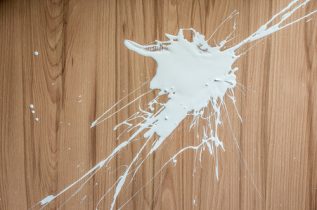Imagine this: you’re in the midst of a home improvement project, painting your walls a beautiful new shade. But as you’re working, a drop of paint, like a rogue soldier, lands on your beloved wood floors. Panic rises, a wave of despair washing over you. “How do I get this paint off?” you cry. Fear not, fellow homeowner, for in this guide, we’ll demystify the art of paint removal from wood floors, equipping you to conquer even the most stubborn paint stains.

Image: woodworkingclarity.com
Getting paint off wood floors can be a daunting task, but knowing the right techniques can make all the difference. From choosing the appropriate tools to understanding the different types of paint, this guide will provide you with the knowledge and confidence to tackle this common homeowner dilemma. Whether you’re dealing with a fresh paint spill or a stubborn old stain, we’ll walk you through the process step-by-step, ensuring that your wood floors remain pristine and beautiful.
Assess the Situation: What Kind of Paint and Wood Floor?
Before you grab your cleaning supplies, take a moment to assess the situation. The type of paint and the type of wood floor will determine the best course of action.
- Paint Type: The type of paint (latex, oil-based, or enamel) can significantly influence the removal process. Latex paints, water-based and typically found in most home improvement stores, are usually easier to remove than oil-based paints, which require more aggressive cleaning methods. Enamel paints are durable and often used for high-traffic areas. They are harder to remove and require a more careful approach.
- Wood Floor Type: Not all wood floors are created equal. Knowing the specific type of wood will help you choose the right cleaning method. Hardwood floors, typically made from oak, maple, or cherry, are durable and can withstand more aggressive cleaning methods. Softwoods like pine or fir are more prone to scratches and require a gentler approach.
Tools and Supplies: Your Weaponry Against Paint
Armed with the right tools and supplies, you’ll be ready to face this paint-removal challenge head-on.
- Protective Gear: Always prioritize safety! Wear gloves to protect your hands from harsh chemicals and a mask to avoid inhaling fumes, especially when working with strong solvents.
- Scraping Tools: For paint removal, a scraper is your trusty sidekick. A putty knife or a plastic scraper can be used for fresh spills or lightly adhered paint. For stubborn paint, a metal scraper might be necessary.
- Cleaning Agents: Start with gentle cleaning agents for fresh spills. A mild dish soap solution or a specialized wood floor cleaner might suffice. For tougher stains, you’ll likely need a paint thinner or a mineral spirits-based solvent.
- Cleaning Cloths: Keep a supply of microfiber cloths or old rags on hand for wiping away paint and cleaning solutions.
- Steel Wool or Sandpaper: For stubborn paint that resists scraping, fine-grit sandpaper or steel wool can help remove the paint without damaging the wood floor. Proceed with caution, as too much friction can lead to scratches, especially on softer wood types.
The Removal Process: A Step-by-Step Guide
Now, let’s dive into the nitty-gritty of paint removal. Remember, the goal is to remove the paint without harming your beautiful wood floors.
1. Scrape Away the Surface Paint: For fresh spills, gently scrape away the wet or semi-dry paint using a plastic or putty knife. Work slowly and carefully to avoid scratching the wood underneath.
2. Clean It Up: For fresh spills that haven’t completely dried, wet a microfiber cloth with warm water and a few drops of dish soap. Gently wipe away the paint residue. Avoid soaking the wood, as excessive water can damage the floor.
3. Tackle Dried Paint: For dried-on paint, consider employing a solvent or paint thinner. Caution: Always test the solvent on a discreet area of your floor first, like a corner or beneath a piece of furniture.
4. Apply Solvent Carefully: With a clean microfiber cloth or a paintbrush, apply the solvent directly to the paint stain. Let it sit for a few minutes to soften the paint.
5. Scrub Gently: Using a scrubbing brush or a clean toothbrush, gently scrub the paint stain in a circular motion. Avoid excessive pressure, as it can damage the wood.
6. Remove Residue: After scrubbing, wipe away the loosened paint and solvent with a clean microfiber cloth. Repeat steps 4-5 if necessary.
7. Neutralize the Area: Once you’ve removed the paint and solvent, neutralize the cleaned area with a mild wood floor cleaner or a mixture of vinegar and water.
8. Dry Thoroughly: Allow the floor to air dry completely, ensuring that no moisture remains before applying any protective sealant.

Image: necitizen.com
Expert Insights and Actionable Tips
To achieve the best results, it’s wise to consult professionals. Here are some tips from experienced floor refinishers:
- Preventative Measures: Always protect your floors during a painting project by laying down drop cloths or plastic sheeting. Covering furniture and doors with plastic is also a good idea.
- Use the Right Tools: Choose the right scraping tool based on the paint type and the thickness of the paint stain.
- Work in Sections: Break down large paint stains into smaller sections to make the removal process manageable.
How To Get Paint Off Wood Floors
Conclusion: A Renewed and Vibrant Floor
Removing paint from wood floors is a task that requires patience and the right tools. By meticulously following the steps outlined in this guide, you’ll be able to remove stubborn paint stains and restore your wood floors to their former glory. Remember, safety should always come first when working with solvents and cleaners. If you’re unsure about the best approach, don’t hesitate to seek professional guidance from a flooring expert. Now, get ready to step into a room with beautifully restored wood floors and enjoy the fruits of your labor.






